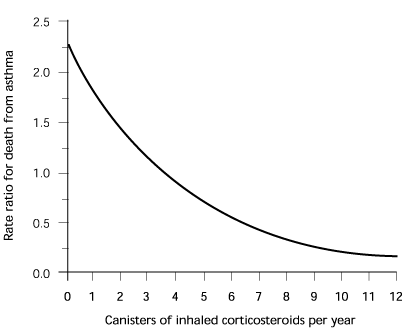
Am Fam Physician. 2001;63(4):733-734
Despite the availability of effective therapies, the worldwide death rate associated with asthma is one to four per 100,000 per year among the general population. The mortality rate is even higher in Canada, and in a 1995 study it was found that deaths related to asthma in the United States had doubled. A significant component of asthma is inflammation rather than bronchoconstriction, and inhaled corticosteroids are the recommended first-line therapy for most patients with asthma. Studies have shown that these drugs decrease the severity of asthma symptoms, reduce rates of hospitalization and improve pulmonary function. However, whether this form of asthma therapy actually prevents death has not been proved. At least three case-control studies found no effect on mortality, but another found that inhaled steroids reduced the combined risk of fatal and near-fatal asthma. Suissa and colleagues performed a population-based epidemiologic study of a large cohort of patients to further examine this issue.
The authors used a computerized database from the Saskatchewan Health System for their research. The database included two million persons covered by the province's national health insurance program. From this database, the authors selected 30,569 patients between the ages of five and 44 who had received at least three prescriptions for an asthma medication during any one-year period from 1975 until 1991. Medications included were various forms of beta agonists, ipratropium bromide, theophylline, cromolyn and inhaled corticosteroids. The patients were followed until age 55, immigration from Saskatchewan, termination of health coverage, December 1997 (when the study ended) or death. The primary outcome of this study was death.
All deaths that occurred during the follow-up period were investigated to determine the cause. Two pulmonologists, who were unaware of any therapies used, reviewed all fatalities that were listed on the death certificate as related to asthma. This cohort comprised the case patients. Each of the patients who died was matched with all available control patients with asthma. The matched control patients had to meet a variety of specific criteria, including use of beta agonists, oral steroids and theophylline, as well as the occurrence of hospitalizations during the two years before the index date.
After identifying at least two control patients for every case patient, the number of canisters of inhaled corticosteroids dispensed during the year before the index date (date of death) was retrospectively determined. This step included both case and control patients. Patients who received at least one canister during each quarter of the previous year were considered to have used inhaled corticosteroids regularly throughout that year.
A total of 562 deaths occurred during the follow-up period, of which 77 were associated with asthma. Acceptable data were collected for 66 patients and compared with data from 2,681 control patients from the entire cohort of patients. The mean age of the case patients was 30 years, with a range from nine to 54 years. All of the study patients were noted to have severe asthma. The case patients had more hospitalizations along with more prescriptions for inhaled, oral and nebulized beta agonists, oral steroids and theophylline.
It was found that 53.0 percent of the case patients and 46.2 percent of the control patients had any use of inhaled steroid in the previous year. However, the mean number of canisters used was 1.57 in the control patients and 1.18 in the case patients. Interestingly, 93 percent of the prescriptions were for low-dose beclomethasone (50 μg per puff). Only one case patient had used six or more canisters of inhaled steroids during the previous year. By means of a continuous dose-response analysis (see the accompanying figure), the authors determined that the death rate from asthma decreased by 21 percent for every additional corticosteroid canister used during the year. They also determined that the death rate from asthma increased among those patients during the first three months of discontinuation of inhaled corticosteroid therapy.
The authors conclude that the regular use of low-dose inhaled corticosteroids is associated with a reduced risk of death related to asthma. These data should reinforce the importance of this therapy in most patients with asthma. Also noted is that the effective therapeutic dosages in this study were less than those associated with adverse events in adults and children, such as cataract formation and growth delay.
